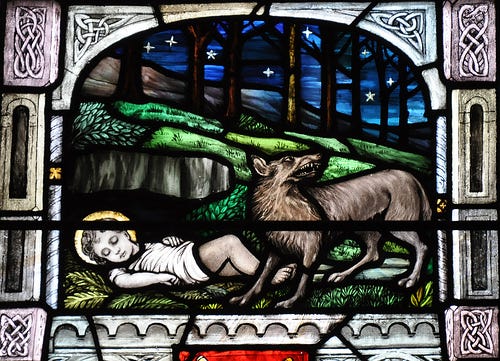Ailbe of Emly: Ireland's Patron Saint of the Wolf
Wolves were so central to the Irish identity that their previous Pagan veneration even made its way into the Christian era
Ailbe of Emly is the patron saint of wolves both in Ireland and worldwide. The story also tells us much of the mysterious transition period from Paganism to Christianity in Ireland within his birth-legend and his later life. Weaving in fairy lore and elements of the wider Indo-European wolf /human mythology, legend tells us that the infant Ailbe was cast out into the wilderness by King Cronan of the Artraighe. This was a result of Ailbe having been the illegitimate child of two of the king's servants. Therefore, the king had refused to allow him to live under his roof or spend his formative years among Cronan's sons.
Similar to the Roman mythology of Romulus and Remus, Ailbe was rescued and reared by a she-wolf at the place known to this day as Leac Ailbhe, Lackelly (St Ailbe's Rock) in County Tipperary. Within the eight century Vitae Sanctorum Hiberniae, we are told that Ailbe was discovered in the forest by visiting Britons who were probably among the first Christians to have visited Ireland in the pre-Saint Patrick era. His human foster parents took Ailbe with them when they returned to Wales. They gave him the name Ailbe. Which is derived from the old Irish words Ail (rock) and beo (alive) as he was discovered alive under a rock where he had been hidden by his wolf foster parent.
Upon reaching adulthood, Ailbe went to Rome and was ordained as a bishop by Saint Hilary, who was then Pope. Towards the end of his life, a "supernatural ship" came to Ailbe and he boarded it, and once inside, he learn the secrets of the mysteries of life and death from the fairy navigators. Returning from the otherworld, he went back to Emly to die and be buried. A monastery was then founded in his honour.
After his death, it is told that a wolf—or werewolf—had fled to Ailbe's monastery to escape from hunters who had been ordered by the king to rid the area of predators. With the words, "Do not fear. It is proper for you to take refuge with me, for as an infant, when humans had spurned me, I was tenderly reared by your kind." Ailbe's spiritual presence then sheltered her.
After this, the wolf—or werewolf—came daily with her four cubs and ate with the brethren. This is a typical allegory to encapsulate the transition from Pagan to Christian Ireland with the image of a wild wolf seeking refuge being a metaphor for conversions.
Saint Ailbe is venerated as one of the four great patrons of Ireland. His feast day is September 12. He is the patron saint of the Archdiocese of Cashel and Emly.







I enjoyed that story. I love how mythology and real people blend over time. I believe that blending preserves these stories , humanities history and understanding of who we were and how we arrived at where we are now. The erasure of our cultural history is one of the things I despise most about the replacement populations of invaders being brought into all the Western World countries.
Too bad the icon of Saint Ailbe seems to have him holding a fox.
That was lovely Thomas.